Owning a John Deere 4100 tractor can be a rewarding experience with its durable build and reliable performance in various agricultural tasks. However, even the sturdiest machines encounter issues over time due to wear and tear or manufacturing defects. You might face common problems such as starting hiccups, electrical glitches, or more substantial mechanical challenges.
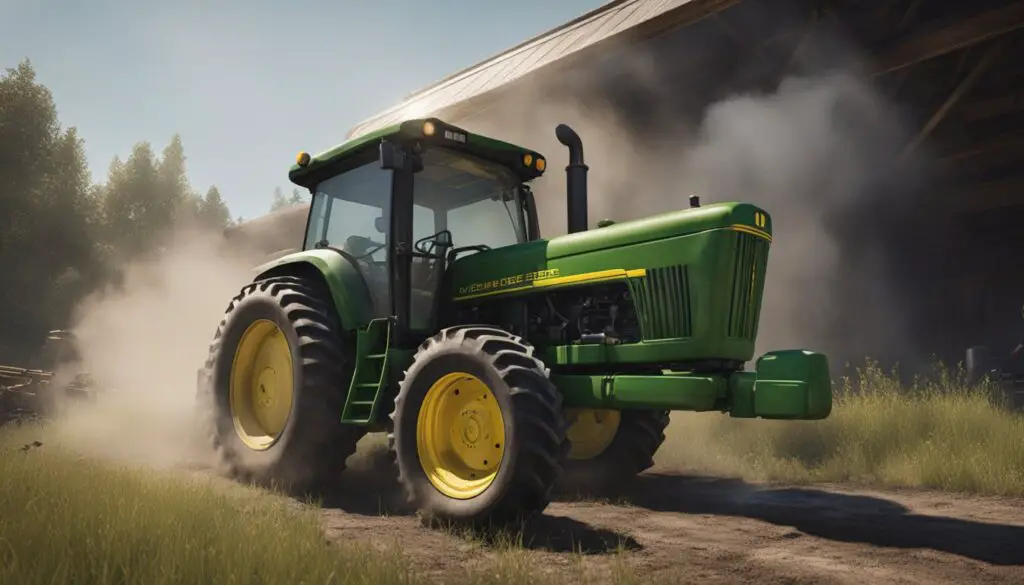
Different problems call for specific solutions, and regular maintenance is key to preventing some of these issues from arising. For example, a damaged PTO clutch might require a part replacement, whereas starting problems could be resolved by flushing the fuel or clearing blockages. Keeping a keen eye on the hydraulic system and steering can also spare you from unexpected downtimes. By addressing issues proactively, you can extend the lifespan of your tractor and maintain its performance.
Key Takeaways
- Regular maintenance minimizes common John Deere 4100 issues.
- Address specific problems like a damaged PTO clutch with appropriate part replacements.
- Early troubleshooting can prevent larger mechanical failures.
Overview of John Deere 4100
The John Deere 4100 is a versatile compact utility tractor that you might find quite handy for a range of tasks from farming to landscaping. Powered by a robust 20 horsepower engine, this small but mighty machine has carved out a place in the hearts of tractor enthusiasts and property owners alike.
Introduced in the late ’90s, the 4100 was part of John Deere’s 4000 Compact Series. It’s designed to be user-friendly, with an intuitiveness that might appeal to both seasoned tractor operators and beginners. Here are some key aspects of this tractor:
- Model: John Deere 4100
- Category: Compact Utility Tractor
- Engine Power: 20 Horsepower
- Series: 4000 Compact Series
Your 4100 is great for a variety of tasks, always ready to be put to work whether it’s plowing snow or tending to your garden. Its size and power are well-suited to small farms, estates, and specialty operations.
While this model generally receives praise for its performance and reliability, it’s not without its flaws. Early on, some design issues were reported. For example, a specific concern was the narrowness of the tractor, which potentially limited certain mid-PTO (power take-off) attachments. Despite these hiccups, many find that the John Deere 4100 meets their farming and landscaping needs quite well.
It’s important that you keep in mind that like any machinery, maintenance is crucial for the health of your tractor. Regular check-ups and replacements when necessary, such as air filters or PTO clutches, can go a long way in ensuring that your 4100 remains a reliable workhorse.
Starting and Electrical Issues
Encountering starting problems with your John Deere 4100 can often be traced back to various electrical system components. This section will walk you through common issues related to the battery and cables, the ignition system, and the safety systems that might prevent your tractor from starting properly.
Battery and Cables
Your John Deere 4100 relies on a strong and reliable battery connection. A dead battery or corrosion on the battery terminals can cause starting issues. Make sure to:
- Check the battery for a full charge; it could be drained over time or by electrical drains.
- Look for corrosion or wear on battery cables which can impede electric flow.
If you find any corrosion, clean the terminals and cable ends with a wire brush. Confirm all connections are tight to ensure proper current flow.
Ignition System
The ignition is critical to starting your John Deere 4100. Issues here might include problems with the spark plug or starter motor. Consider the following steps:
- Inspect the spark plug for buildup or wear; a dirty spark plug will impede starting.
- Listen for clicking sounds, which often indicate problems with the starter motor or a loose connection.
If the starter motor is suspected, check the connections and seek professional assistance if you’re not experienced with electrical repairs.
Safety Systems
Lastly, safety systems are designed to prevent accidents but can also be sources of electrical issues. The tractor’s safety relay could be the culprit if everything else checks out:
- Confirm that the safety relay is functioning correctly; it can sometimes malfunction.
- Electrical problems may arise from the safety switches; these are often overlooked.
If your tractor doesn’t start and you’ve gone through the previous checks, it might be worthwhile to inspect the safety relay or consult with a technician who can diagnose the issue professionally.
Fuel and Carburetor Concerns
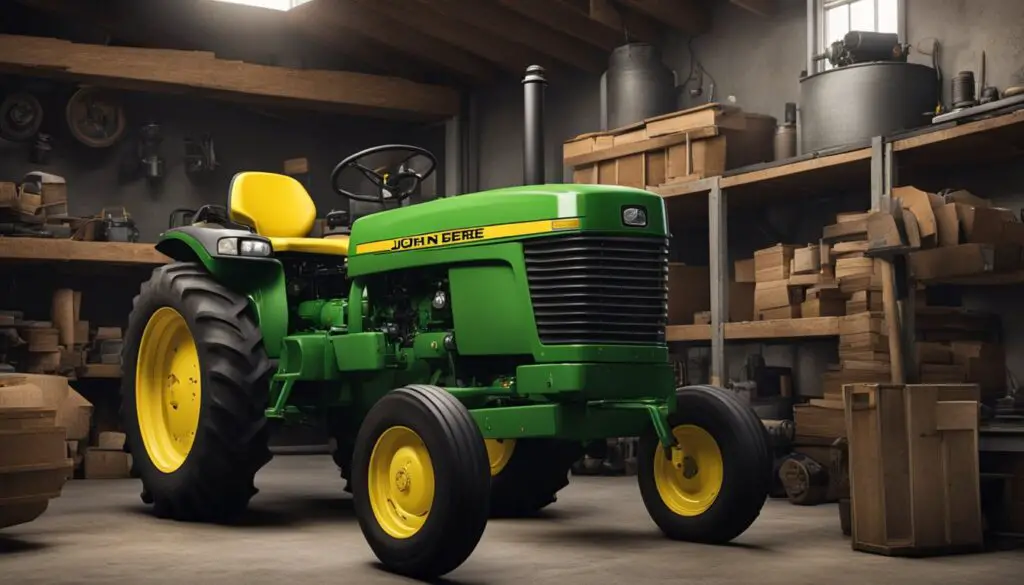
In your John Deere 4100, proper fuel system maintenance and carburetor care are essential for peak performance. Let’s tackle these topics to ensure your tractor runs smoothly.
Fuel System Maintenance
Your tractor’s fuel system is vital to its operation, and keeping it clean is key. Over time, fuel lines can develop blockages or leaks, which can lead to performance issues.
- Regular Inspection: You should regularly check your fuel lines and filters for signs of wear or damage.
- Clean Fuel: Always use clean, fresh fuel to prevent buildup and residue in your system.
- Timely Filter Replacement: Change your fuel filter as recommended to prevent clogging, which can starve your engine of fuel.
Carburetor Specifics
The carburetor is responsible for mixing fuel and air before combustion; a dirty carburetor can cause starting problems or uneven running.
- Carburetor Maintenance: Regularly inspect your carburetor for dirt and debris. If your engine is running rough, it might be time for cleaning.
- Cleaning Solutions: A special carburetor cleaning additive can help remove build-up. However, for heavy residue, you may need mechanical cleaning.
- Proper Adjustments: Ensure the carburetor settings are adjusted for optimal air-fuel mixture, particularly after cleaning.
Remember, a well-maintained fuel system and clean carburetor are your best defenses against common engine problems.
Transmission and Drive Issues
In your John Deere 4100, maintaining the transmission and drive train in good working order is crucial for smooth operation. Here’s what you need to check to troubleshoot common issues related to these systems.
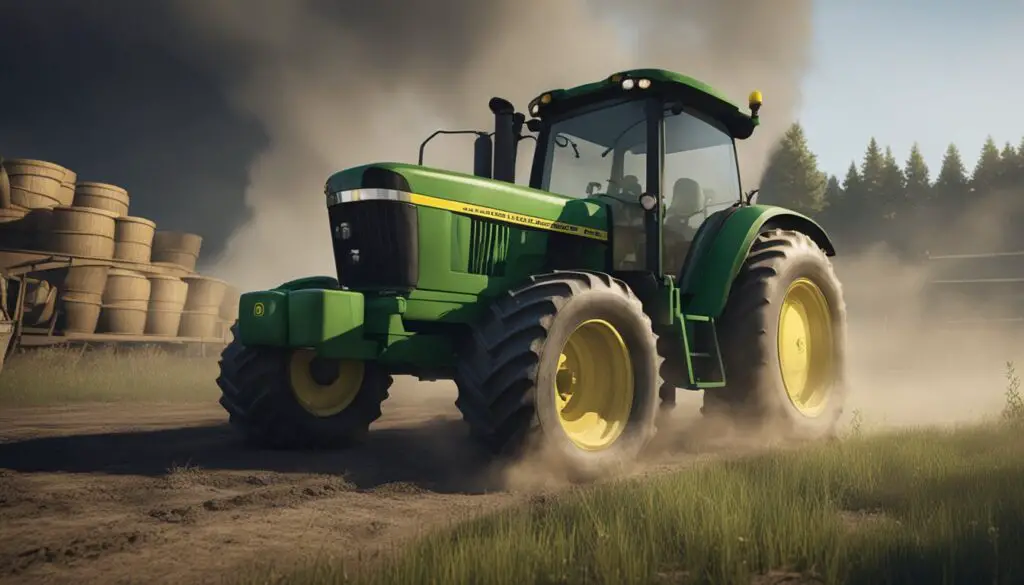
Transmission Fluid and Level
Your tractor’s ability to function smoothly hinges on the correct level and cleanliness of the transmission fluid. Make sure to:
- Check the fluid level regularly as per the user manual’s instructions.
- Look for signs of contaminated fluid which might appear dirty or smell burnt.
- If the fluid is low or dirty, refill or replace it with the type specified for your John Deere 4100.
Drive System Components
The drive system components such as the drive belt, pulleys, and gearbox input shaft play a pivotal role in transmitting power. To avoid transmission problems:
- Inspect the drive belt for wear or damage and replace if necessary.
- Ensure the pulleys are functioning smoothly without excessive play or noise.
- Check the gearbox input shaft for signs of wear and service as required to prevent future drive issues.
Hydraulic and Steering Problems
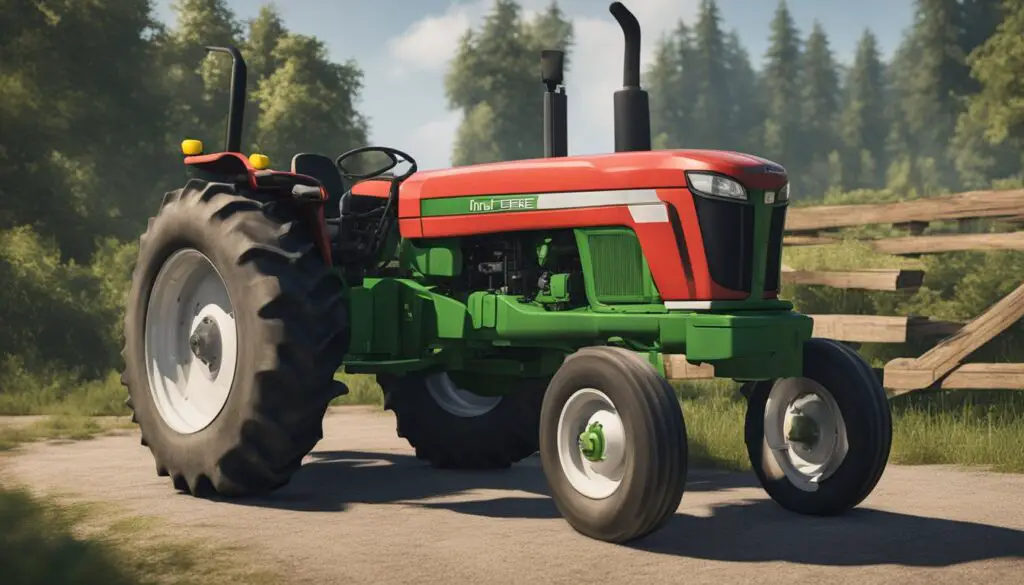
When tackling hydraulic and steering problems in your John Deere 4100, it’s essential to understand the systems’ intricacies and locate the root cause effectively.
Hydraulic System Overview
Your John Deere 4100’s hydraulic system is crucial for smooth operation. Hydraulic issues can range from jerky movements to complete failure. Hydraulic malfunctions are often indicated by unusual whining noises when the system is under load. Causes could be linked to the hydraulic pump, clogged filters, or faulty lines. If you experience sudden hydraulic stoppage during operation, like bush-hogging, check your system’s hydraulic fluid and filters first. A decline in hydraulic power or leaks can also suggest problems with the hydraulic line or seals.
Steering Mechanism
Regarding the steering on your John Deere 4100, the steering pump and steering cylinder are common culprits when issues arise. If your steering is hard to turn initially, but improves as the tractor warms up, a malfunctioning steering pump could be the problem. This could be exacerbated by a blockage in the lines or a failing cylinder. Look out for signs of hydraulic leaks near the steering assembly, as these can lead to a loss of pressure and result in inadequate steering response. Remember, regular maintenance of hydraulic and steering systems can prevent most issues.
Maintenance and Regular Upkeep
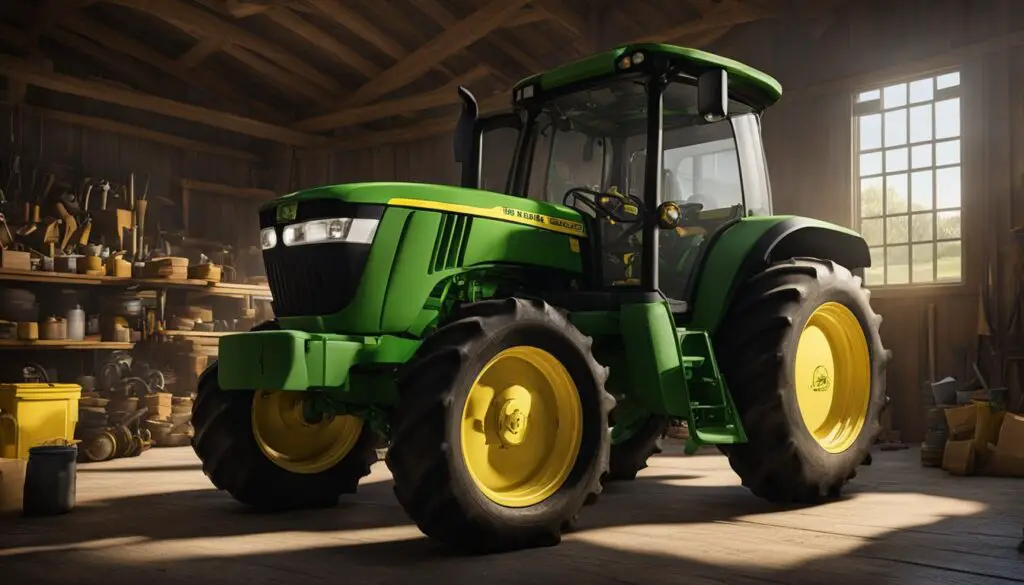
Proper maintenance is crucial to the performance of your John Deere 4100, including regular checks on cooling systems to avoid overheating. Staying on top of these tasks will ensure long-term efficiency and reliability.
General Maintenance
Your routine maintenance should cover several key aspects to keep your tractor in prime condition:
- Engine Oil: Regular oil changes are vital. Check your oil level frequently, and replace the oil and oil filter as prescribed by the manufacturer’s guidelines.
- Air Filter: A clogged air filter can lead to engine inefficiency. Inspect and replace it according to the usage and environment you operate in.
Use this checklist to guide your regular maintenance:
| Task | Frequency |
|---|---|
| Check engine oil level | Before every use |
| Replace engine oil and filter | As per user manual |
| Inspect air filter | Monthly |
| Clean air filter | As needed |
| Check tire pressure | Before every use |
| Grease all fittings | After 50 hours of use |
Cooling and Overheating
The cooling system is essential to prevent your tractor from overheating, which can be detrimental to the engine’s longevity.
- Coolant Levels: Ensure the radiator’s coolant level is within the recommended range. Top it up if necessary.
- Radiator and Thermostat: Periodically inspect the radiator for debris and clean it. Also, test the thermostat to ensure it is opening and closing properly to regulate the engine temperature.
Remember to check:
- Radiator fins and coolant level every 50 hours.
- Thermostat function at the start of each season or after 100 hours of use.
Taking the time to perform regular maintenance on your John Deere 4100 can prevent common problems and prolong the life of your tractor.
Additional Mechanical Issues
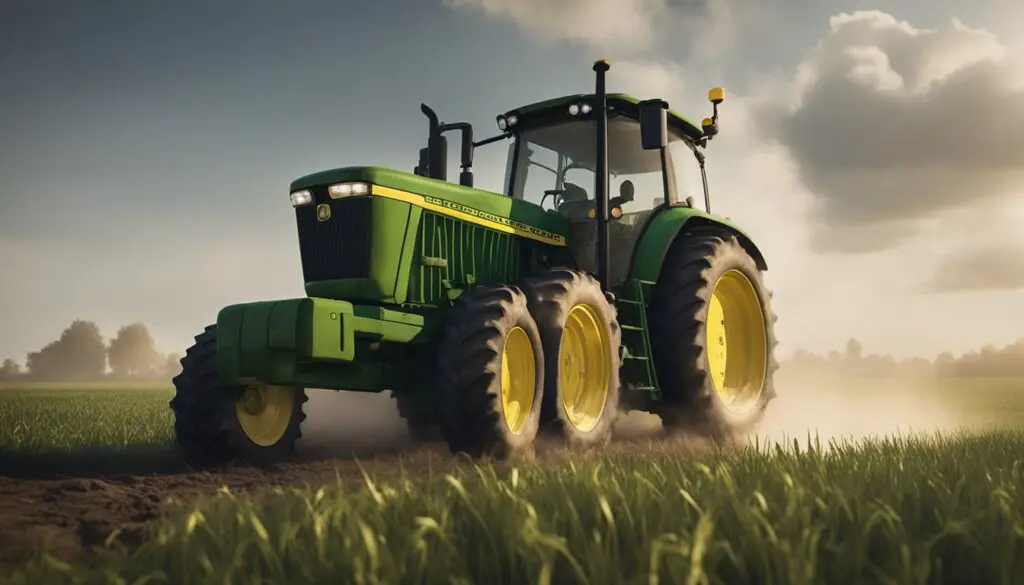
In managing your John Deere 4100 tractor, it’s important to be aware of potential mechanical issues that go beyond routine engine troubles. Key areas to monitor include the mower deck and PTO clutch, as well as the axle and wheels, which can experience various problems affecting performance.
Mower Deck and PTO Clutch
Your mower deck is prone to vibration if not properly maintained. To minimize this, regularly check that all connections are secure. For a damaged PTO clutch, symptoms might include an inability for the mower to engage or disengage properly, which can stem from a faulty PTO switch or worn components. Here’s a quick checklist:
- PTO Clutch:
- Ensure the PTO switch is functioning.
- Inspect for physical damage and replace parts as necessary.
- Mower Deck Vibration:
- Tighten any loose parts.
- Check for and replace any bent blades or damaged components.
Axle and Wheels
With your axle, be alert for noises or rear end issues that could hint at required repairs or even an axle upgrade kit installation. For the wheels, maintaining correct tire pressure is crucial for proper traction and to reduce strain on the axle. Consider these tips:
- Axle:
- Listen for any unusual sounds which may indicate a problem.
- Evaluate for a potential axle upgrade kit if you’re experiencing recurring issues.
- Wheels:
- Regularly check and adjust tire pressure to match the manufacturer’s specifications.
- Inspect tires for wear and replace them if needed to preserve axle health.
Performance and Handling
When operating your John Deere 4100, you expect a reliable and efficient performance, whether you’re managing agricultural tasks or landscaping. You also want handling that feels responsive and tuned to the challenges of the terrain and the tasks at hand.
Engine Performance Factors
Your tractor’s 19 hp Yanmar 1.0L 3-cyl diesel engine is designed for a balance of efficiency and power in a compact frame. Here’s what you need to monitor to maintain optimal engine performance:
- Engine Power and Cylinder Health: Regularly check the health of your engine’s cylinders, as a misfiring or stuck cylinder can lead to power loss and increased vibration.
- Airflow to Engine: A clogged air filter restricts airflow, which can cause your engine to struggle. Replace the air filter periodically.
- Fuel System: Ensure that your fuel pump is delivering a clean and steady supply of diesel; a clogged system can cause your engine to work slowly when starting.
Handling and Tasks
For both agricultural and landscaping tasks, how your tractor handles can make a significant difference.
- Vibration: Excessive vibration can be a sign of issues with engine performance or mechanical troubles; resolving them will improve handling.
- Smooth Task Execution: Utilize your tractor’s PTO clutch effectively. If it gets damaged, replace necessary components promptly to avoid getting stuck in the middle of a task.
An attentive eye on these specific areas ensures that your John Deere 4100 tractor performs effectively and handles tasks smoothly, enabling you to focus on the job at hand without the worry of unexpected problems.
Troubleshooting Common Problems
When your John Deere 4100 encounters issues, a systematic approach to troubleshooting can get you back on track quickly. Let’s break down the process to identify the symptoms and resolve the common problems your tractor may face.
Identifying Symptoms
Your John Deere 4100 may display a range of symptoms that can signal a problem:
- Starting Issues: If your tractor fails to start, check for a charged, properly connected battery.
- PTO Clutch Malfunction: A damaged PTO clutch may prevent proper operation. This could involve electrical problems such as faulty wires or a bad switch.
- Engine Performance: Sluggish engine start or loss of power could be due to a clogged air filter or fuel blockages.
Identifying the correct symptom is your first step to effective troubleshooting.
Resolving Issues
To tackle the symptoms, here are straightforward solutions:
- Starting Problems:
- Ensure the battery is charged and connections are secure.
- Inspect starter motor and solenoid for functionality.
- PTO Clutch Damage:
- Replace damaged wires, switches, and fuses.
- Apply a protective coating to new wiring to prevent future issues.
- Engine Problems:
- For fuel-related issues, clean the fuel lines and replace filters if necessary.
- Regularly replace the air filter to prevent airflow restriction that can hinder engine performance.
Remember, consistent maintenance is a surefire way to prevent most common issues from arising with your John Deere 4100.
John Deere 4100 Specifications
Your John Deere 4100 is a compact utility tractor, which was part of the 4000 Compact Series. Designed for various agricultural and landscaping tasks, it comes with a notable set of specifications to meet your needs.
Engine and Power
- Engine Type: Yanmar 3TNE74 diesel
- Cylinders: 3
- Horsepower: 20.5 hp
- PTO (Power Take-Off) Horsepower: 16.5 hp
Transmission and Chassis
- Transmission Type: Hydrostatic – 2 range
- Drive: 4WD
- Brakes: Wet disc
- Steering: Power
Dimensions and Weight
- Weight: 1,400 lbs (635 kg) approximately
- Wheelbase: 55.1 inches (139.9 cm)
- Length: 99.6 inches (253 cm)
Capacities
- Fuel Tank: 5.8 gallons (22 L)
- Hydraulic system: 4.8 gallons (18.2 L)
Attachments
- John Deere tractors like the 4100 were compatible with a variety of attachments, including loaders and mowers, increasing their versatility for all kinds of tasks on your property.
By understanding your tractor’s specifications, you can better appreciate its capabilities and maintenance needs. Whether you’re tending to your land or engaging in more demanding agricultural tasks, these specifications ensure that your John Deere 4100 is up to the challenge.
Frequently Asked Questions
In this section, you’ll find common issues related to the John Deere 4100 tractor and guidance to troubleshoot them, focusing on the hydraulic system, loader, and engine performance.
What are common hydraulic system issues in the John Deere 4100?
Your John Deere 4100 may experience hydraulic system issues such as leakages, decreased pressure, or slow operation, often due to worn seals or clogged filters.
How do you troubleshoot front end loader hydraulic problems?
Check the hydraulic fluid levels first, then inspect hoses, fittings, and connections for leaks. It’s crucial to ensure the pump is primed properly to avoid air in the system.
Where is the hydraulic pump located on a John Deere 4100?
The hydraulic pump on your John Deere 4100 is typically located at the front of the tractor, attached to the engine block.
How to rebuild a cylinder for the John Deere 410 loader?
Rebuilding a cylinder involves disassembling it, replacing seals and worn parts, then reassembling and testing for leaks. It’s recommended to refer to the service manual for specific procedures.
Are there known starting issues with the John Deere 4100?
Yes, the John Deere 4100 may have starting issues due to a weak battery, bad connections, or fuel delivery problems. Regular maintenance can help prevent these issues.
Why is my John Deere 4100 losing power during operation?
Power loss during operation can be caused by clogged air filters, fuel system issues, or engine overheating. Ensuring clean filters and proper engine maintenance is key.
Last updated on September 7, 2025
